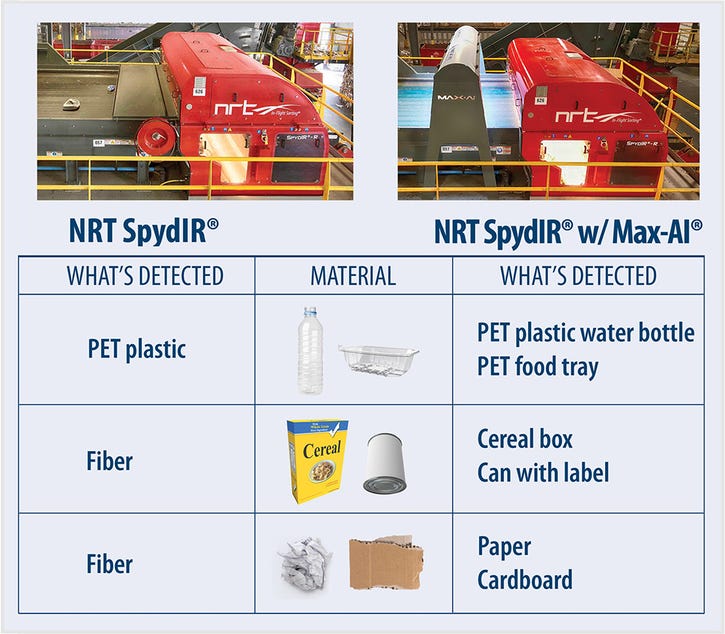NRT Adds Max-AI Technology to Optical Sorters
During its initial installation at Penn Waste, Max-AI was integrated with a SpydIR unit that was designed to sort out paper at the pre-sort to a container line.

National Recovery Technologies (NRT) has integrated the company’s NRT SpydIR optical sorter with Max-AI technology, creating a new sorter with detection abilities for today’s optical sorter market.
NRT’s SpydIR technology uses near infrared light (NIR) detection to identify plastics, paper, wood and other materials by material type. Max-AI technology uses artificial intelligence (AI) to identify materials using a camera and neural network algorithm (NN). The NRT SpydIR with Max-AI optical sorter employs both detection technologies to create an optical sorter that is able to combine the information from each technology to deliver a unique sorting capability.
In its initial installation at Penn Waste in York, Pa., Max-AI was integrated with a SpydIR unit that was designed to sort out paper at the pre-sort to a container line. The unit was seeing a significant quantity of steel cans with fiber labels that were being ejected by the optical unit. Max-AI is able to identify these cans and suppress the firing signal in the optical unit to prevent contamination in the fiber stream. Not only is Max-AI able to identify this material, but it is able to do so at speeds of 600 feet per minute (fpm) on the optical feed belt. Thus, material quality increased dramatically as did the recovery of both fiber and ferrous cans.
“Competing in today’s recycling markets is tough,” said Tim Horkay, Penn Waste director of recycling operations, in a statement. “Our investment in this new technology is immediately paying off with both higher purity of our fiber and greater recovery of steel cans. The two technologies complement each other well.”
“Max-AI technology is remarkable in that it can detect multiple views of different material categories in one location using a camera and AI, similar to how a person can using his or her eyes and brain—the difference being Max can do this at very high speeds,” said Matthias Erdmannsdoerfer, NRT president, in a statement. “While our SpydIR line of optical sorters is fantastic at identifying materials very confidently at high volumes, it is limited to material composition analysis. Recyclers care about more than material type, and this is where Max comes in. We can now sort using the SpydIR’s speed and confidence while adding the criteria that Max is able to differentiate. For example, in a PET sorting application, while the optical sorter identifies the material PET, Max is able to differentiate between different types of PET like thermoform tray, redemption container, food-grade, rigid, bottle and more. Thus, the customer is able to produce a product with increased value at a minimal additional expense without the need to add labor. It is among the most impactful innovations in optical sorting in recent memory.”
Other examples of the capability of this combining of technology are shown in the chart below.

About the Author
You May Also Like


.png?width=300&auto=webp&quality=80&disable=upscale)